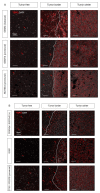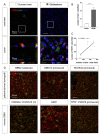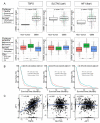Glioblastoma Exhibits Inter-Individual Heterogeneity of TSPO and LAT1 Expression in Neoplastic and Parenchymal Cells
- PMID: 31963507
- PMCID: PMC7013601
- DOI: 10.3390/ijms21020612
Glioblastoma Exhibits Inter-Individual Heterogeneity of TSPO and LAT1 Expression in Neoplastic and Parenchymal Cells
Abstract
Molecular imaging is essential for diagnosis and treatment planning for glioblastoma patients. Positron emission tomography (PET) with tracers for the detection of the solute carrier family 7 member 5 (SLC7A5; also known as the amino acid transporter light chain L system, LAT1) and for the mitochondrial translocator protein (TSPO) is successfully used to provide additional information on tumor volume and prognosis. The current approaches for TSPO-PET and the visualization of tracer ([18F] Fluoroethyltyrosine, FET) uptake by LAT1 (FET-PET) do not yet exploit the full diagnostic potential of these molecular imaging techniques. Therefore, we investigated the expression of TSPO and LAT1 in patient glioblastoma (GBM) samples, as well as in various GBM mouse models representing patient GBMs of different genetic subtypes. By immunohistochemistry, we found that TSPO and LAT1 are upregulated in human GBM samples compared to normal brain tissue. Next, we orthotopically implanted patient-derived GBM cells, as well as genetically engineered murine GBM cells, representing different genetic subtypes of the disease. To determine TSPO and LAT1 expression, we performed immunofluorescence staining. We found that both TSPO and LAT1 expression was increased in tumor regions of the implanted human or murine GBM cells when compared to the neighboring mouse brain tissue. While LAT1 was largely restricted to tumor cells, we found that TSPO was also expressed by microglia, tumor-associated macrophages, endothelial cells, and pericytes. The Cancer Genome Atlas (TCGA)-data analysis corroborates the upregulation of TSPO in a bigger cohort of GBM patient samples compared to tumor-free brain tissue. In addition, AIF1 (the gene encoding for the myeloid cell marker Iba1) was also upregulated in GBM compared to the control. Interestingly, TSPO, as well as AIF1, showed significantly different expression levels depending on the GBM genetic subtype, with the highest expression being exhibited in the mesenchymal subtype. High TSPO and AIF1 expression also correlated with a significant decrease in patient survival compared to low expression. In line with this finding, the expression levels for TSPO and AIF1 were also significantly higher in (isocitrate-dehydrogenase wild-type) IDHWT compared to IDH mutant (IDHMUT) GBM. LAT1 expression, on the other hand, was not different among the individual GBM subtypes. Therefore, we could conclude that FET- and TSPO-PET confer different information on pathological features based on different genetic GBM subtypes and may thus help in planning individualized strategies for brain tumor therapy in the future. A combination of TSPO-PET and FET-PET could be a promising way to visualize tumor-associated myeloid cells and select patients for treatment strategies targeting the myeloid compartment.
Keywords: Iba1; LAT1; PBR; SLC7A5; TSPO; glioblastoma.
Conflict of interest statement
The authors declare no conflicts of interest.
Figures







References
-
- Leibetseder A., Ackerl M., Flechl B., Wohrer A., Widhalm G., Dieckmann K., Kreinecker S.S., Pichler J., Hainfellner J., Preusser M., et al. Outcome and molecular characteristics of adolescent and young adult patients with newly diagnosed primary glioblastoma: A study of the Society of Austrian Neurooncology (SANO) NeuroOncology. 2013;15:112–121. doi: 10.1093/neuonc/nos283. - DOI - PMC - PubMed
-
- Verhaak R.G., Hoadley K.A., Purdom E., Wang V., Qi Y., Wilkerson M.D., Miller C.R., Ding L., Golub T., Mesirov J.P., et al. Integrated genomic analysis identifies clinically relevant subtypes of glioblastoma characterized by abnormalities in PDGFRA, IDH1, EGFR, and NF1. Cancer Cell. 2010;17:98–110. doi: 10.1016/j.ccr.2009.12.020. - DOI - PMC - PubMed
-
- Brito C., Azevedo A., Esteves S., Marques A.R., Martins C., Costa I., Mafra M., Bravo Marques J.M., Roque L., Pojo M. Clinical insights gained by refining the 2016 WHO classification of diffuse gliomas with: EGFR amplification, TERT mutations, PTEN deletion and MGMT methylation. BMC Cancer. 2019;19:968. doi: 10.1186/s12885-019-6177-0. - DOI - PMC - PubMed
MeSH terms
Substances
Grants and funding
LinkOut - more resources
Full Text Sources
Medical
Research Materials

